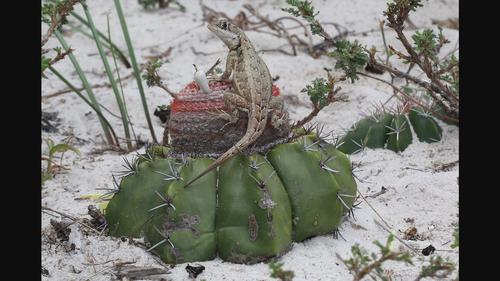当前位置:
X-MOL 学术
›
Austral Ecol.
›
论文详情
Our official English website, www.x-mol.net, welcomes your feedback! (Note: you will need to create a separate account there.)
Double mutualism involving Melocactus (Cactaceae) and lizards in the Brazilian Caatinga: Another isolated case or is it an established interaction?
Austral Ecology ( IF 1.5 ) Pub Date : 2024-02-21 , DOI: 10.1111/aec.13494 Alexsandro Bezerra‐Silva 1 , Vanessa Gabrielle Nóbrega Gomes 2 , Sinzinando Albuquerque‐Lima 3, 4 , Tarcila Lima Nadia 5 , Isabel Cristina Machado 4 , Ligia Silveira Funch 1
Austral Ecology ( IF 1.5 ) Pub Date : 2024-02-21 , DOI: 10.1111/aec.13494 Alexsandro Bezerra‐Silva 1 , Vanessa Gabrielle Nóbrega Gomes 2 , Sinzinando Albuquerque‐Lima 3, 4 , Tarcila Lima Nadia 5 , Isabel Cristina Machado 4 , Ligia Silveira Funch 1
Affiliation

|
This work discusses a fascinating ecological relationship, in which the lizard Tropidurus cocorobensis and the cactus Melocactus violaceus engage in a double mutualism. In this interaction, observed in a Caatinga, a dry tropical forest in Northeastern Brazil, T. cocorobensis feed on the nectar and pollen of M. violaceus , transferring the grains to the stigmas of another flower, acting as a potential pollinator. Additionally, the lizards consume fruits of M. violaceus , helping to disperse the seeds. The concentrated nectar of M. violaceus attracts lizards, and the morphological compatibility between the small pink flowers and the size of T. cocorobensis is important to this double mutualism. The findings mentioned here highlight the importance of Tropidurus lizards in the reproductive success of Melocactus species and provide insights into the coevolution of these species in a seasonal and resource‐scarce environment, like the Caatinga.
中文翻译:

巴西卡廷加的 Melocactus(仙人掌科)和蜥蜴的双重互利共生:另一个孤立的案例还是一个既定的相互作用?
这项工作讨论了一种有趣的生态关系,其中蜥蜴科科罗布龙 和仙人掌紫花仙人掌 从事双重互利共生。在巴西东北部的卡廷加干燥热带森林中观察到的这种相互作用中,科科罗贝西斯 以花蜜和花粉为食紫罗兰分枝杆菌 ,将谷物转移到另一朵花的柱头上,充当潜在的传粉媒介。此外,蜥蜴还吃以下水果:紫罗兰分枝杆菌 ,帮助传播种子。浓缩花蜜紫罗兰分枝杆菌 吸引蜥蜴,粉红色的小花和大小之间的形态相容性科科罗贝西斯 对于这种双重互利关系很重要。这里提到的调查结果强调了特罗皮鲁斯 蜥蜴的繁殖成功率蜜饯属 物种,并提供有关这些物种在季节性和资源稀缺环境(如卡廷加)中的共同进化的见解。
更新日期:2024-02-21
中文翻译:

巴西卡廷加的 Melocactus(仙人掌科)和蜥蜴的双重互利共生:另一个孤立的案例还是一个既定的相互作用?
这项工作讨论了一种有趣的生态关系,其中蜥蜴



























 京公网安备 11010802027423号
京公网安备 11010802027423号